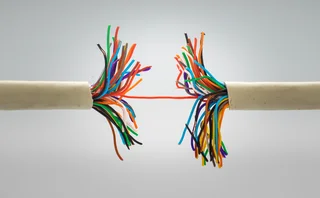
Energy Risk Software Rankings: dealing with volatility
Volatility triggers greater need for commodity trading and risk management software
Click here to view the software tables
Whipsawing commodities prices during 2021, especially in the last quarter, meant that it was vital for commodities firms to be able to monitor their positions very close to real time, to have visibility into their risk exposures and to have the tools to manage and mitigate those risks.
These imperatives increased the need for firms to have robust commodities trading and risk management (CTRM) software systems at the heart of their operations. As well as the need to improve position management, market and credit risk, demand grew for tools to manage physical risk, scheduling and logistics. The appetite for analytics development also grew at many firms.
Energy Risk’s annual Software Rankings survey shows which CTRM and enterprise risk software systems were considered the most proficient across a variety of different areas in the commodities landscape during 2021 and into 2022. In the survey – now in its 17th year – participants vote for their preferred software vendors and applications, data providers, data management firms and implementation specialists. The poll covers CTRM and enterprise risk systems, trading platforms, data firms and implementation specialists.
While price volatility has made operating in commodities markets challenging recently, the reopening of economies after lockdowns and the resulting commodity boom has fuelled growth in many small to mid-sized commodities firms. This in turn has created the need for more sophisticated trading and risk management functionality. According to a software survey which ran alongside the Software Rankings poll, many firms want to see more processes in their CTRM systems being automated.
In the survey, which polled software users and implementation specialists about the use of commodities software, 70% of respondents said their organisation planned to increase automation within their CTRM systems this year. When asked what their organisation is ultimately trying to achieve through making changes to the CTRM software landscape, 75% of respondents said it wanted to increase operational efficiencies. The major factor driving firms to make changes – voted for by 51% of respondents – was given as growth of the company, with increased market complexity being the second most popular reason.
In the 2022 Software Rankings, the CTRM section is once again dominated by Ion Commodities and Hitachi Energy and the enterprise risk section by Lacima. Veson Nautical tops the shipping category, with SmartFreight coming first for land transportation. Meanwhile, KWA Analytics and Lacima feature throughout the technology advisory section.
Methodology
The survey went live on December 14, 2021 and closed on February 14, 2022. It received 584 valid responses. To compile the Software Rankings, respondents were asked to vote for their preferred software vendor, data management firm, data provider and technology adviser in a variety of categories. All votes were carefully checked and invalid votes stripped out. Examples of votes considered invalid are people voting for their own firm or using a free internet-based email address, multiple votes from the same person or IP address, and voters who choose the same firm indiscriminately throughout the survey.
Following closure of the poll, the results are subject to an internal review process, which can result in categories being dropped if they do not have enough votes. The outcome of the review is final.
More on Risk management
CRO interview: Shawnie McBride
NRG’s chief risk officer Shawnie McBride discusses the challenges of increasingly interconnected risks, fostering a risk culture and her most useful working habits
Increasingly interconnected risks require unified risk management
Operational risk is on the rise according to a Moody's survey, making unified risk management vital, say Sapna Amlani and Stephen Golliker
Energy Risk Europe Leaders’ Network: geopolitical risk
Energy Risk’s European Leaders’ Network had its first meeting in November to discuss the risks posed to energy firms by recent geopolitical developments
Energy Risk US Leaders’ Network: tackling volatility
Energy Risk’s inaugural US Leaders’ Network convened in Houston in October to discuss risk management challenges caused by geopolitical upheaval, policy uncertainty and volatility
LNG trading strategies set to change amid major market shifts
The global LNG market is on the brink of significant changes set to alter trading dynamics and market behaviour, say analysts
Why commodity finance is ripe for stablecoin
Digital currency brings cost efficiencies to financing, but its real benefit to commodity firms lies in making huge pools of new capital available, write Jean-Marc Bonnefous and Ronan Julien
US shutdown leaves commodity traders without key data
Commodity traders are ‘flying blind’ without Commitment of Traders reports
Energy Risk at 30: Learning from the past
Energy Risk looks back at the seminal events and developments that have shaped today’s energy markets







